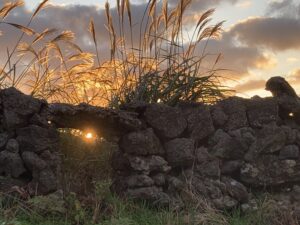As a volcanic island, Jeju is covered in stone, most of which is basalt, a hard lava rock with many holes. While the stony ground made farming difficult, it also provided material for construction. The many stone walls of Jeju are collectively called ‘doldam’.

A government official during the Goryeo dynasty named Kim Gu ordered the construction of the ubiquitous stone walls around Jeju’s fields. These are known as ‘batdam’. When he came to the island, farmlands had no clear boundaries, so stronger and unscrupulous people often encroached on the land of their weaker neighbors. Taking pity, Kim Gu ordered the islanders to construct the batdam as property markers. He held the office of ‘pangwan’, a position similar to a judge, and his tenure lasted from 1234 until 1239.

Large stone walls were also built along the coastline during Goryeo times to protect against invasion from the sea. Only a few sections of these fortifications, the Hwanhae Jangseong, remain today. In the Joseon dynasty, thick stone walls called ‘seongdam’ were built around Jeju’s three main towns and nine military forts. Horses and cattle were put to pasture during this time, and three extensive fences called ‘jatseong’ or ‘jatdam’ were built to control their movement.

We don’t know when the practice began, but low stone walls were built around graves to keep animals out and protect the burial mounds from fire. People built walls around their homes called ‘jibdam’ and along paths from their homes to main roads, which are known as ‘olledam’. Jeju’s basalt rocks were also used in the construction of fishing weirs along the coast called ‘weondam’.

